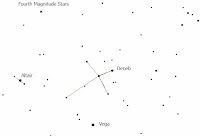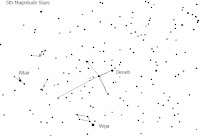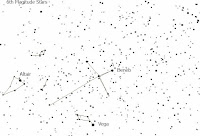 I know the night sky pretty well, but I still found it tricky to match up what I was seeing on the Sky Count star charts with what I was seeing in the sky. So I've taken the liberty of labeling a few of the bright stars and drawing in some constellation lines. These charts might help you out if you want to head out and see how many stars you can spot in Cygnus, the Northern Cross. You can click on them to make them bigger, of cours, and probably print them to use them "in the field" with your red flashlight. I use my bicycle tail light.
I know the night sky pretty well, but I still found it tricky to match up what I was seeing on the Sky Count star charts with what I was seeing in the sky. So I've taken the liberty of labeling a few of the bright stars and drawing in some constellation lines. These charts might help you out if you want to head out and see how many stars you can spot in Cygnus, the Northern Cross. You can click on them to make them bigger, of cours, and probably print them to use them "in the field" with your red flashlight. I use my bicycle tail light. If you like looking at the stars at all, do get outside during the next night or two, before the moon gets bright, and see how many stars you can see from your location. You can figure out your latitude and longitude from Google Maps, and report your findings on the Great Worldwide Star Count website.
If you like looking at the stars at all, do get outside during the next night or two, before the moon gets bright, and see how many stars you can see from your location. You can figure out your latitude and longitude from Google Maps, and report your findings on the Great Worldwide Star Count website. It's not many times one gets to contribute to real science without needing a lot of equipment and training.
It's not many times one gets to contribute to real science without needing a lot of equipment and training.Speaking of equipment, I'm still experimenting with getting good star pictures with minimal fuss and equipment. I brought my camera and a regular tripod with me when I headed out to count stars. The picture below, shows the stinger of Scorpius' tail as a vertical pair of stars a little left of center at the bottom edge of the picture, just to the right of a cactus. The teapot of Sagitarius is standing on its spout with the bottom of the teapot on the left and the top of the cap to the right. The spout is a little to the left of the middle of the picture, partway into the Milky Way. The handle is a little down from the top of the image. Half way between the stinger and the spout of the teapot is M7, an open cluster of stars.
 So I mounted the camera on my trusty tripod, used a 28mm lens at f2.8, and took some 15 second and some 8 second exposures at ISO 800. I could pick these exposure times from the camera's menu, so I didn't need a cable release or remote trigger device. When I got home and looked at the pictures at 100% size, I could see that the stars had moved during the 15 second exposures, but they appeared quite round in the 8 second exposures.
So I mounted the camera on my trusty tripod, used a 28mm lens at f2.8, and took some 15 second and some 8 second exposures at ISO 800. I could pick these exposure times from the camera's menu, so I didn't need a cable release or remote trigger device. When I got home and looked at the pictures at 100% size, I could see that the stars had moved during the 15 second exposures, but they appeared quite round in the 8 second exposures.
Having said all that, it is interesting that the picture here is a combination of three 15 second exposures that I've downsized for easier viewing online. The stars look round enough in this small size image. (well you can hardly see them at all in the thumbnail. I'm really referring to the 1024x768 image you'll see if you click on the thumbnail) The 15 second pictures showed a lot more Milky Way than the 8 second ones, so I used the 15 second images, and downsized them.
So, if you have a DSLR and happen to be somewhere where you can really see the stars, have a go at taking a picture or two, even if you have to prop up the camera with a rock on the roof of your car and use the self timer to trigger the shot. You won't get a prize winning photo, but you might be surprised by what you can see in that image. I shot some 8 second images of Cygnus while I was out star counting and they showed MANY more stars than I could see with my naked eye. I'm still snooping around Bonaire for a great foreground of cacti, in front of a non light polluted western horizon. I can find one or the other, but not both.... so far.
No comments:
Post a Comment